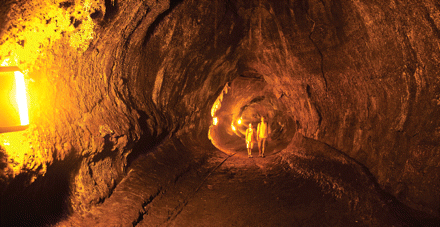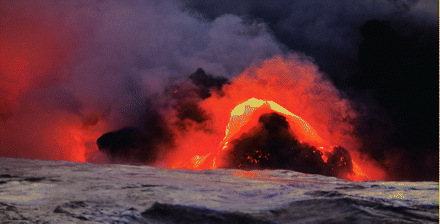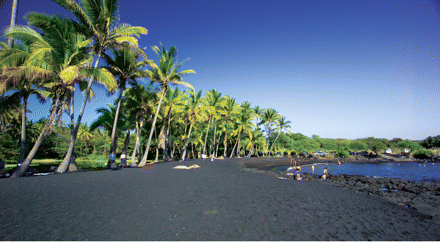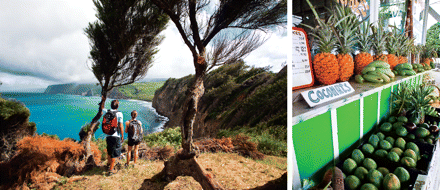Walk on Lava or Choose Beaches of Green or Black
Abstract
The Big Island of Hawaii provides a study in contrasts. For one thing, it is big: about twice the combined land area of all the other Hawaiian Islands.
For another, the climate varies abruptly from section to section of the island. In general, the east side of the island is wet and the west is dry, but there is plenty of variation as one drives the long loop around the island.
The Kohala Coast, at the northwest corner of the island, gets barely five inches of rain a year. Hilo, the west side's main city, gets 10 feet of rain a year.

The Thurston Lava Tube in Hawaii Volcanoes National Park is a natural tunnel left behind by a river of molten lava.
Part of the difference is due to the height of Mauna Kea, the volcano near the island's center, which traps clouds and moisture. Officially, Mauna Kea stands 13,796 feet above sea level. But islanders like to say that it's the tallest mountain in the world (taller than Everest at over 32,000 feet)—if you measure from its base at the bottom of the Pacific Ocean.
The mountain's peak is home to the W. M. Keck Observatory, which houses the world's largest telescope and is the main attraction among 11 instruments peeking into the cosmos. The Onizuka Visitor Information Station is the last point for regular cars. Getting all the way to the top, another 4,000 or so feet, takes a four-wheel drive.
Island Rapidly Growing
The old joke about real estate is that no one is making any more of it. That doesn't hold true in Hawaii Volcanoes National Park, where lava flows from Kilauea since 1983 have added 560 acres (and counting) to the eastern edge of the Big Island.

Lava flows from the Big Island's active volcano into the sea.
To local residents, however, the eruption is no joke. Lava has already covered several towns, a 12th-century Hawaiian temple, and the Kaimu Black Sand Beach.
Nonetheless, the volcano does provide some entertainment in return. An evening drive down Route 130 and a short walk leads to the Puu Oo volcanic cone and extraordinary views of glowing red lava streaming down the mountain into the sea. The light show is temperamental, so call the park rangers at (808) 985-6000 to see what's happening the day you're there.

Punaluu Black Sand Beach and its palm trees offer an update on the conventional vision of a beach.
Farther south, along Route 11 between the park and town of Naalehu, lies Punaluu Black Sand Beach, where jet-black shores rimmed with coconut palms are an unforgettable sight. Hawaiian Green Sea turtles are often seen basking on the beach along with the tourists. The turtles are described as "calm, sweet creatures," harmless to humans, but they are an endangered species and should be admired but not touched or bothered.
More adventurous types might check out the Mahana (Green Sand) Beach, at the southern tip of the island, a 12-mile drive off Highway 11. The dark green of the beach comes from a mixture of eroded lava rock and volcanic olivine. Getting there takes a two and-a-half mile hike to the shore (unless you have a four-wheel-drive vehicle), and the final descent to the beach is described as "difficult and treacherous."
Green Sand Beach is near Ka Lae, the southernmost point in the United States and the point at which the first Polynesians arrived in the Hawaiian Islands sometime between A.D. 400 and A.D. 800.
Hilo Highlights
When the return to civilization beckons, Hawaii's second largest city awaits. Hilo, on the wet side of the island, may be rainy on most days, but the town scores style points when the sun is shining.
The waterfront's Banyan Drive, at the east end of Hilo Bay, is lined with the eponymous trees, planted in the 1930s by well-known visitors such as Babe Ruth, Amelia Earhart, and Cecil B. DeMille.
A few steps from the drive lies the bridge to Coconut Island, an excellent vantage point from which to view the city.

Left: Hikers along the Hamakua Coast, west of Hilo. Right: The Hilo Farmer's Market opens on Wednesdays and Saturdays.
Nearby Liliuokalani Gardens is a perfect spot for a picnic lunch. This formal Japanese garden bears the name of Hawaii's last reigning monarch, Queen Liliuokalani. It was built in the early 1900s as a memorial to the immigrant Japanese workers on the island's sugar plantations. Visitors can stroll through 30 acres of Hawaiian and Asian plantings and see Japanese-style walkways, pagodas, ponds, and bridges. Admission is free.
For a take on another of Hawaii's many ethnic groups, the Lyman Museum and Mission House combines architectural styles of the islands and New England, from whence Protestant missionaries came in the 19th century to convert the natives to Christianity.
For a real taste of Hawaii, knowledgeable visitors search out the hard-to-find Nori's Saimin and Snacks (688 Kinoole Street). Saimin is something like gourmet ramen noodles. The dish originated in Japan and consists of a bowl of steaming broth and noodles accompanied by your choice of meats and vegetables.
Those with a sweet tooth may want to stop in Hilo at Big Island Candies, home to a huge variety of cookies baked on the premises and dipped in chocolate (585 Hinano Street, <www.bigislandcandies.com>).
Finally, the Hilo Farmer's Market offers fresh fruits, vegetables, flowers, prepared foods, and crafts every Wednesday and Saturday at the corner of Kamehameha Avenue and Mamo Street.
The Hawaiian Volcano Observatory provides daily updates on the Web, describing where and how the lava and other materials cast out of the volcano are heading. Its Web site is <http://volcanoes.usgs.gov/hvo/activity/kilaueastatus.php>.



